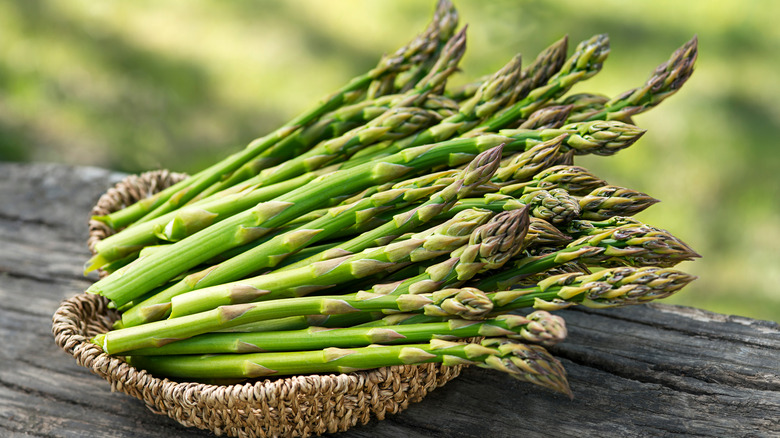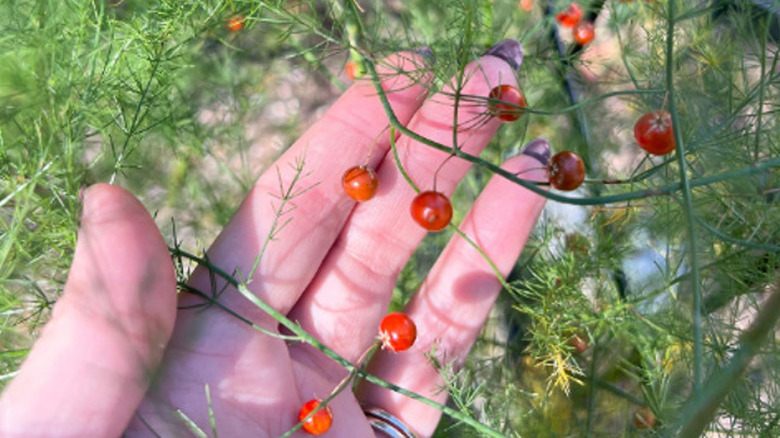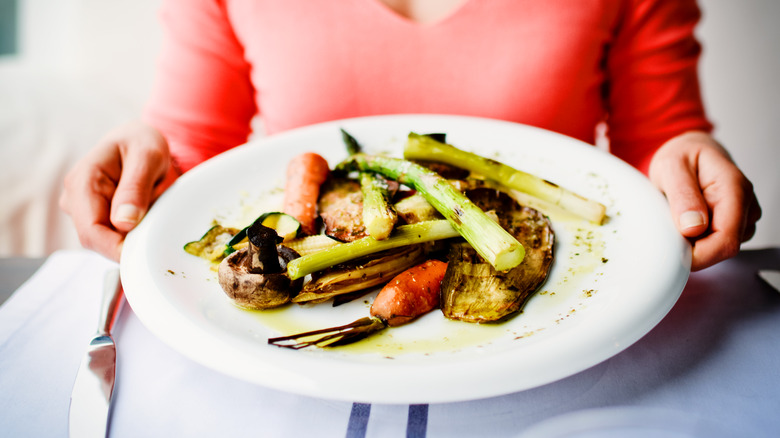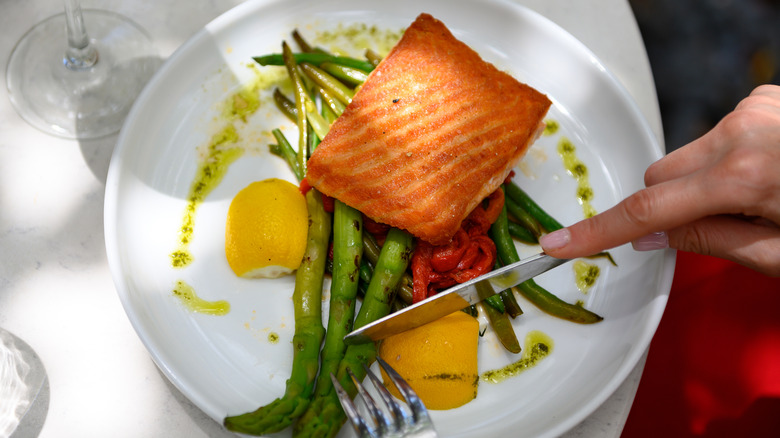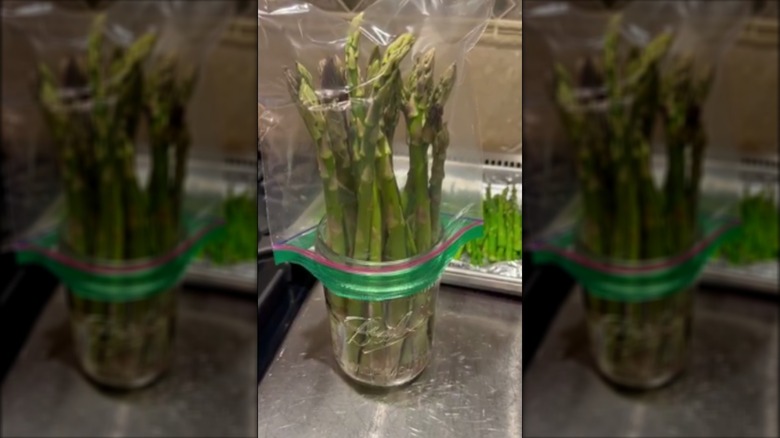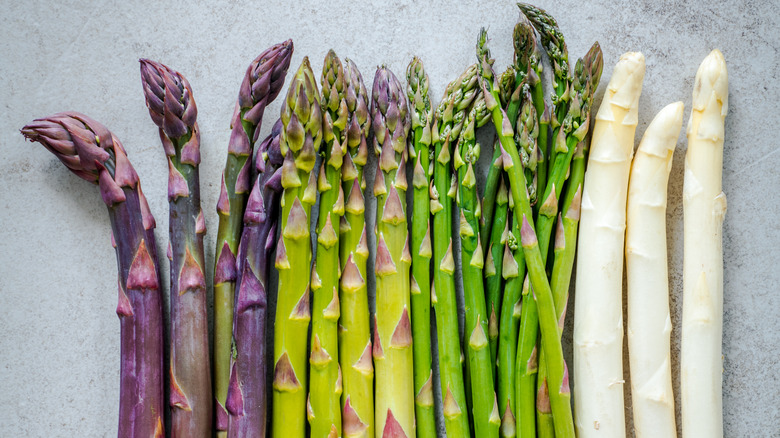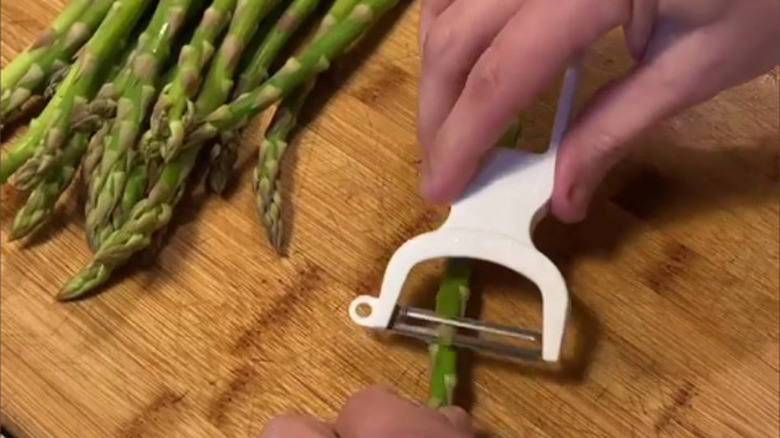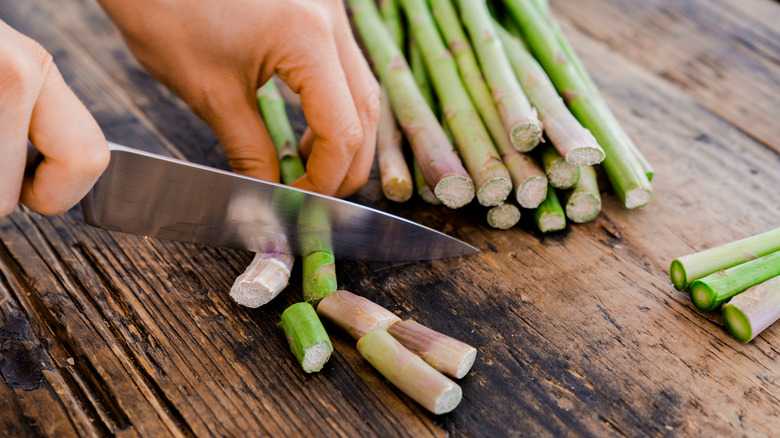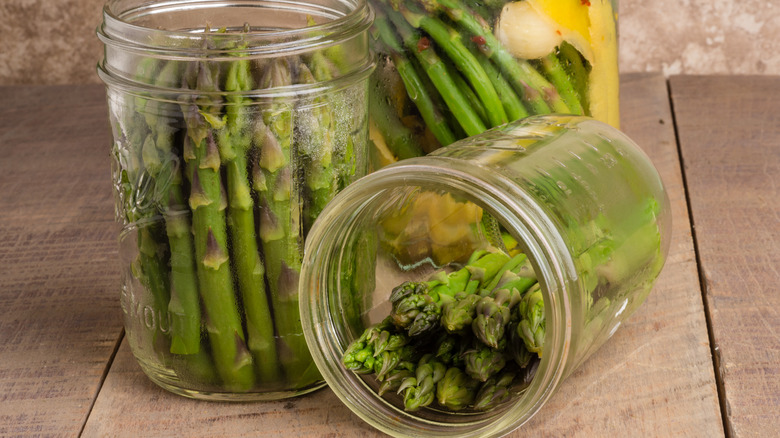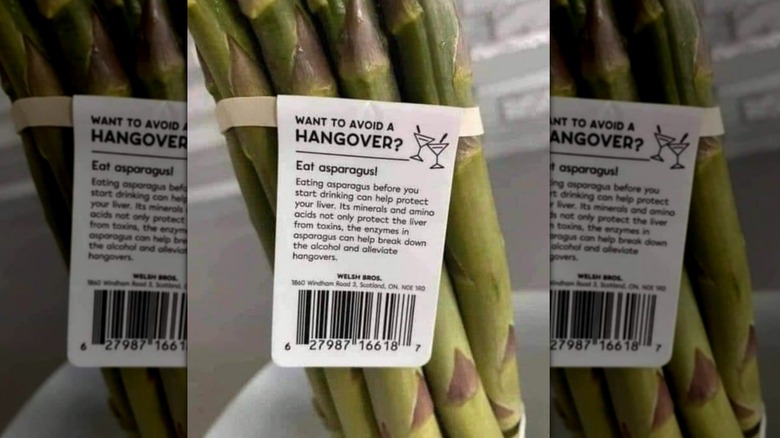False Facts About Asparagus You Thought Were True
Asparagus, with its visually striking color and distinct earthy flavor, is quite possibly one of the most beloved vegetables out there. "If every green vegetable was as delicious," said an asparagus-loving poster on Reddit, "I would struggle a lot less with my eating habits." Growing straight up out of the ground, the stalks we season and roast, sear, or grill in our homes are actually the stems of the asparagus plant. Believed to have its origins in the Eastern Mediterranean region of the world, the vegetable is now cultivated worldwide, providing humans with a delicious and diverse way to access loads of key vitamins and nutrients.
But just as with any popular food, word gets around ... and sometimes, twisted around. In the case of the slender dark green veggie, there appears to be some information circulating the globe that is either overblown or just plain untrue. From misunderstandings regarding shelf life to incorrect cooking techniques to misconceptions spread via TikTok, here are some false "facts" about asparagus that you probably thought were true.
False: It's 100% good for you
It's true that asparagus is packed full of vitamins such as K, C, E, A, and B6, along with minerals like iron, potassium, calcium, and antioxidants, to name a few. But while its status as a superfood can't be denied, many don't realize that the only part of the asparagus plant containing these benefits is the stem.
The part of the asparagus that we harvest and eat is actually the stem of what becomes a much larger plant. If allowed to continue growing upward rather than cut, the asparagus stems mature and eventually blossom into plant adulthood, producing small, bright red berries that are surprisingly (and completely) poisonous to people. According to the Modern Farmer, it would only take consuming a few to send your body into the throes of misery with diarrhea and vomiting — a far cry from the wonderful, beneficial bodily effects nibbling on its stems produces. Add this one to your mental list of berries never to eat if you come across them in the wild.
False: You can eat as much of it as you want
Asparagus is low in calories and chock-full of the good nutrients your body needs to function at maximum capacity ... so this means you get a free pass to eat the entire roasted panful yourself, right? Well, yes and no. For someone without any pre-existing health conditions, chowing down on a good-sized portion of the plant spears shouldn't cause any negative side effects. However, for a select few individuals — such as those with kidney concerns or people taking blood thinning medications — there could very well be too much of a good thing.
Asparagus, being low in potassium, is generally considered a safe addition to a renal diet — or a dietary plan developed with the health of the kidneys in mind. However, the Cleveland Clinic does attach a recommendation of six stalks maximum at a time for those with kidney diseases to keep the total amount of potassium consumed under control. The vegetable also contains a good amount of vitamin K, which causes a diuretic effect. Those taking blood thinners are encouraged to eat fewer foods containing this particular vitamin, and this includes asparagus (via Guthrie.org). Of course, speaking with your doctor is the only surefire way to assess your body's unique individual requirements. Still, if you fall into either of these health categories, moderation might be worth taking into consideration.
False: Only certain people have smelly pee after consuming it
Though not the most pleasant side effect up for discussion, it's one we can't ignore; eating asparagus makes for smelly pee. But why exactly does this happen? According to Indiana University Health, the outrageously strong scent we smell in the bathroom post-asparagus consumption is caused by sulfur-like compounds contained in the green vegetable. As it begins to digest, these compounds start breaking down in our bodies ... eventually filtering out as stinky amino acids in our urine.
But here's the truth: this process looks the same for each individual. Every human on earth will get rid of these sulfur-filled amino acids through urination while processing asparagus, and therefore, everyone will have the same foul-smelling result when they do. So why do some people claim it doesn't happen for them?
As it turns out, the individuals who claim not to experience the phenomenon of post-asparagus pee are not immune to it ... they simply cannot smell it. As many as one-third of humans are born with an inability to process the pungent smell. This stems from a genetic variation in their olfactory system, which renders certain scents — in this case, asparagus-pee — undetectable. While we aren't sure if this should be celebrated, not having to experience that foul smell in the bathroom post-asparagus meal isn't exactly a terrible fate, either.
False: It's only good for three days in the refrigerator
When you buy a pack of fresh asparagus from the grocery store, your timer for using it starts — and, generally speaking, you do have about three to five days on the clock before your veggies begin to get slimy. However, this timeline for freshness only applies if you immediately throw the spears in your fridge's vegetable drawer, still wrapped up in the plastic bag in which you bought them. If you take a few extra minutes to prep the vegetables before storage, you can extend their shelf life up to ten days.
The process is similar to placing a beautiful bouquet of blooms in a vase: trim the woody ends off the stems and store them vertically in a cup or jar with a little water. Next, tuck them in a safe pocket of your refrigerator and pull them out when you're ready to season and steam. However, be on the lookout for cloudy water — if the liquid seems dirty, pour it out and replace it. Your asparagus will thank you by staying good nearly twice as long as they ordinarily would have. Now, isn't that worth the extra few minutes post-grocery shopping?
False: It's always green
While it's easy to believe that asparagus is an exclusively green vegetable if you're from the United States, nothing could be further from the truth. There are actually three different variants of asparagus: green, white, and purple. While the green version of the versatile veggie is overwhelmingly used in America, preferences are different in other countries.
In Europe, for example, it is much more common to see white asparagus at the market. While white asparagus is the exact same type of plant as the green, it is simply matured underground, away from the sunlight. It is exposure to the sun's rays, as the asparagus stems pop up from the dirt, which naturally turn stalks a deep green. By keeping asparagus underground intentionally, you maintain its whiteness — giving it a slightly sweeter flavor and a more tender texture than if it had been allowed to see the light of day.
Purple asparagus, however, is a unique variety in its own right. It has a higher sugar content than both its green or white cousins and is described as having a less "grassy" and more nutty flavor. Masterclass reports that the purple vegetable variant was originally developed and harvested in Italy, although it is now cultivated throughout the world. While the flavors of the three different kinds of asparagus differ slightly, their nutritional content is the same — making any color of the asparagus rainbow a safe bet for your next meal.
False: You should cook large stalks as is
The vast majority of us probably buy a pack of asparagus at the store, trim the ends, and throw them on a roasting pan. It's true that if your spears are nice and slender, preparation can be as simple as that ... but sometimes, you may encounter a bunch that needs a bit more attention in the way of cooking. Thick asparagus spears, especially, may require one additional step before they're popped into the oven: peeling.
Peeling asparagus involves shredding off that outer layer of skin on the stalk using a blade, much like one would when preparing whole carrots. While this may not be necessary for extremely thin variants of the vegetable, it could make things quite a bit easier to eat — and to cook — when it comes to the really thick ones. Because stockier asparagus stalks tend to be the largest around their base, peeling these high-circumference areas will cause them to be of equal thickness throughout — making for a more even cook. In addition, the skins of larger asparagus tend to be tough and fibrous, so you may have an overall more enjoyable eating experience by taking the time to shed that outer skin.
False: You can't eat the woody ends
It's so commonplace that it comes practically as second nature for most of us — when you prep a pack of asparagus, you chop off those pesky ends. If you've ever forgotten this step and gone ahead with cooking, you'll probably never forget trying to bite through that tough bottom piece at the kitchen table. Probably, you were unable to; the ends of asparagus spears called the woody ends, are so incredibly tough and fibrous that we've all just gone ahead and assumed they are inedible. Maybe even dangerous.
"I ate the woody ends of the asparagus," reads the title of a thread on Quora. "Is that bad?" Thankfully, a helpful fellow user hopped on and put the worried user's mind at ease by sharing the truth: that pale, hard end, though really chewy and tough, is still completely edible. It's a well-known fact in the culinary world that the woody ends of asparagus are wonderful for developing purees or sauces. Dozens of recipes for asparagus-end soup exist out there, as well, just waiting to be utilized by consumers ... the vast majority of which have been throwing them away all this time. Next time you chop off those ends, instead of heading straight for the trash, consider bagging them up for a unique recipe attempt the following day. You'll not only be reducing food waste, but you may just find your newest favorite dish in the process.
False: You can't freeze it
There are things you can freeze, and there are things you can't — at least, not without destroying the texture or quality of the product, that is. And many of us have probably assumed that asparagus falls into the 'cannot' category for years. This is presumably because of its high water content, which renders many fruits and vegetables unable to withstand the temperatures of freezers without turning to unappetizing mush. However, it appears we may have been wrong to assume that the lanky vegetable can't take the heat — or should we say, the freeze.
According to BBC Goodfood, freezing asparagus is not only possible but advantageous. Preserving the nutritious vegetable makes it possible to enjoy it even when it is out of season, allowing you to access all that nutritious, delicious flavor any time of year. The thicker the asparagus stalks, the better when it comes to freezing them, and there are a few additional tips to take note of before attempting. If you freeze asparagus raw, it will likely become a mushy mess when it comes time to thaw. A quick blanch, or even cooking in advance before tossing into the ice box, should take care of the problem — making the finished product as close to fresh as possible when you're ready to consume. An added bonus is that preparing from frozen should also reduce your cooking time. What's not to love about getting dinner out faster?
Fact: It's not safe to can at home
Canning is an excellent tool that allows for vegetables, beans, fruits, or meats to be preserved well past their ordinary shelf life — in some cases, up to a whopping five years past. And it seems that more and more people are foregoing the grocery-store brands of canned or pickled goods, opting to do it in their own kitchens instead.
However, when it comes to asparagus, there's a rumor that attempting to can it yourself will always end in botulism — a deadly and sometimes life-threatening toxin that can be present in improperly canned food items. This is because asparagus is a low-acid food and cannot fight off the growth and development of botulism spores the same way that high-acid foods naturally would. Because of this, many have written asparagus off as a lost cause for home canning.
However, there does exist a way to safely preserve your own favorite vegetable spears safely. Using a pressure canner, those sneaky botulism spores can be completely killed off before you seal up those green goods. And since the University of Minnesota reports that 90% of cases of botulism come from home-canning projects gone wrong, it is essential that you invest in a pressure canner before you take on the project of canning your own asparagus. As long as you do, you can go ahead and preserve your favorite spears fear-free.
False: It's toxic for dogs and cats
It happens to the best of us; Fido swoops in and inhales something we drop on the ground before we can pick it back up. Sometimes, these are simple chunks of something harmless, maybe even beneficial, for our four-legged family member. Other times, though, it might be something not-so-great for our food-swiping dogs and cats. But before you go into a panicked tailspin and rush off to the vet's office the next time your furry friend snags an asparagus spear in the kitchen, take a breath. The assumption that the green veggie is poisonous to animals is false.
As it turns out, asparagus is totally non-toxic for both dogs and cats. On the contrary, all its vitamins and minerals can be beneficial for them, just as they are for us. However, there are a few things to watch out for when it comes to your beloved animal's consumption of the vegetable. Because of their long shape and sometimes stringy, fibrous texture, asparagus spears can present a major choking hazard for animals — especially given how quickly they tend to lap up scraps they find on the floor. This risk is especially high if the spears are raw, so if you are intentionally giving them to your animals for health benefits, we recommend getting those pieces nice and soft beforehand — similar to the care you would take in steaming for a baby or another learning chewer.
False: It magically cures hangovers
TikTok is known for having some major influence over viral trends, and in 2021, the video platform went wild over an unexpected green vegetable. That's right, asparagus. Handfuls of users took to the internet to spread the "fact" that the healthy green spears were a drinker's best friend. Why? They supposedly cured the troublesome symptoms associated with a hangover.
However, experts say that this declaration has been a bit exaggerated. There is no hard scientific evidence saying that asparagus in and of itself can cure a hangover. As reported by Today, a cell study conducted in 2009 indeed showed that both human and rat cells were better protected from toxicity after receiving asparagus extract — but the study was done using lab cultures, not actual people. In addition, asparagus may not be the best choice for dining while drinking for another reason: it contains an impressive amount of fiber. Since the nutrient promotes activity in the digestive system, too much might cause an already queasy, booze-filled tummy to become even queasier.
However, on the other hand, if you consider the veggie's high water content, it does make sense that it would naturally amplify hydration, which, as we all know, plays a vital role in both hangover avoidance and recovery. So, if you want to give it a try, we say go for it. The veggie is a health powerhouse, after all. It just might work for you.
